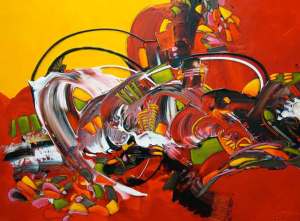As promised folks I’m going to provide you with a few exercises and suggestions for your workbook this month. The down side of me doing this is that i will expect to see these particular things covered in your sketchbooks though. If you do come up with a new or creative approach to any of them, that’s great. Nothing has to be done in any particular way.
The art to the left here has nothing to do with your projects, or at least it didn’t when I sat down to prepare this post. I wanted to find something new to me, that interested me and brought color to the page, and in looking I discovered this article; Esther Barend: Spontaneous Art which then led me to the website of the artist; http://www.estherbarend.eu/ . Having done this of course I decided that I’d want you guys to go through a similar process to me, that’ll be project 1, explained below.
A reminder to eveeryone that these things are due in on the first day back after X-mas. It’s not my intention for you to ruin your holidays, there’s nothing to stop you getting onto these projects right away. Here’s the list of work;
- Decide on a type of art that might interest you, not specifically a school of art, more of an idea or theme. Hit the internet (if you are reading this I know you have access) and find an example of such a piece of work that you like. Follow that art back to it’s home and learn a little about the artist and the piece. Present this search, and the fruits of your labours in a page or two of your book (remember to always cite your sources) and then, follow that up with a piece of your own art on that theme. My own search began with the term “Spontaneous Art” and it lead me to the artist above. This should in total occupy at least two pages, but could be easily three to five (or more if you really like)
- Draw hands. Really. Like a lot of hands, fill a page with drawings of your own hands, or the hands of someone else. Don’t draw them too big to fill the page faster, big hands means more detail. Be sure to look at real hands while you do this, I want drawing of hands the way you see them, not the way you think they look. Don’t erase any, don’t scratch any out, no matter how poorly you think they may be turning out. Practice makes perfect. This is only one page, though as always, you could do more.
- Inspired by Skye, inspired by Skye’s mother it seems, in a two page spread in your book I want you to examine what you see as your comfort zone in art. Examine what you draw the most, and what you avoid. Try to figure out what you hide behind and what challenges you might need to confront to grow as an artist. Imagine at least one project that you can do in your book to tackle something outside your comfort zone, and then do it! An example of my comfort zone are the high contrast portraits of people that I sometimes paint. I am most comfortable eliminating the range of values that we see in real life to present the “essence” of the person in an approach that breaks the person into shapes and negative spaces. This also stops me from having to labour over tonal shifts, and measuring the value in a subject with normal lighting. To combat this I created the self-portrait done entirely in a range of value, without creating shapes that hangs in the classroom today.
- I will stop here this month. Next month we’ll decide if this is too much direction, or not enough. Feel free to comment and ask for more if you want more. Or comment to ask questions, or look for clarification.
